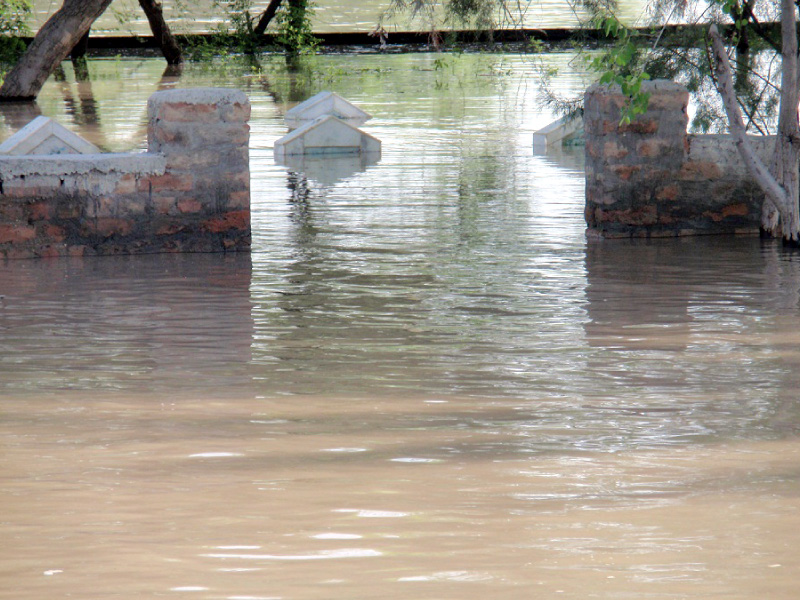
For Mai Bakhshul, uprooting her family and shifting home every monsoon is a norm. She moved to the embankment with her ailing husband and other family members. Shifting to embankments during floods, and later back to the villages has become a routine for them. According to her, the katcha (riverbed) area is more fertile than other lands. “The area turns more fertile after the floods,” she said.
“Life in katcha is not easy but we have been living here since a very long time and that is why we love it.” Bakhshul also mentioned that many families brought their stocks of grains and cattle with them, but many were unable to do so because of the rising water.
Bakhshul hails from Abdullah Shah village, situated in the katcha area of Soomro-Panhwari protective embankment near Pano Akil. Like dozens of other villages, this village is also surrounded by flood water and the residents have started to move to safe places along with their cattle.
In the 2010 disaster caused by the flood, the water level went high enough to destroy the mud-house settlements. Bakhshul said that human lives, households and cattle were affected at that time. “This year, the water has not entered our village, but the mosque and graveyard have drowned.”
Floods - 2010 and 2013
For Ramzan, there is no huge difference but one in the floods of two years ago and this year. The memories of the devastating floods of 2010 are still fresh in his mind. “The difference between the two floods,” he continued, “is that in 2010, the residents of the katcha did not get much time to evacuate, hence everything was submerged.” This year, the floods were potentially devastating but they got time to evacuate.
Ramzan is a resident of the same village and he has already moved to higher ground for safety. According to him, the water level is continuously rising and it will not take much time to flood the village. “This year, the rise in River Indus reminds us of the super flood of 2010, which had washed away thousands of villages,” he said while remembering the 2010 flooding.
Safety at stake
Villagers are facing dual problems: the rising River Indus and the bandits. “Our forefathers used to say that in their time, nobody was worried about any sort of theft or crime,” Ramzan shared. He added that living in the village is now unsafe because the bandits are more powerful than the police. Following the inundation, hundreds of families have shifted to higher grounds, especially to the embankments, and there is nobody to safeguard their lives and assets.
Locals suggest that the government should deploy policemen at the embankments to save the villagers from bandits and other criminal elements.
Government claims a farce?
While the government claims to help, locals report otherwise. According to Bakhshul, the government is claiming that rescue and relief operations are being carried out, but in reality only a few boats are there to help villagers and some people from NGOs evacuate. “The people from the NGOs are distributing food items, tents and water coolers among the displaced.”
Fakir Mohammad, who moved to the embankment from Panhwari village, complained about the government’s indifference to their plight. “We moved to the embankments four days ago, but nobody is taking care of us. Our children and cattle are suffering from different diseases and we really need medical assistance, but it seems that the government has nothing to do with the people of katcha,” said a disgruntled Fakir.
Published in The Express Tribune, August 24th, 2013.






































COMMENTS
Comments are moderated and generally will be posted if they are on-topic and not abusive.
For more information, please see our Comments FAQ